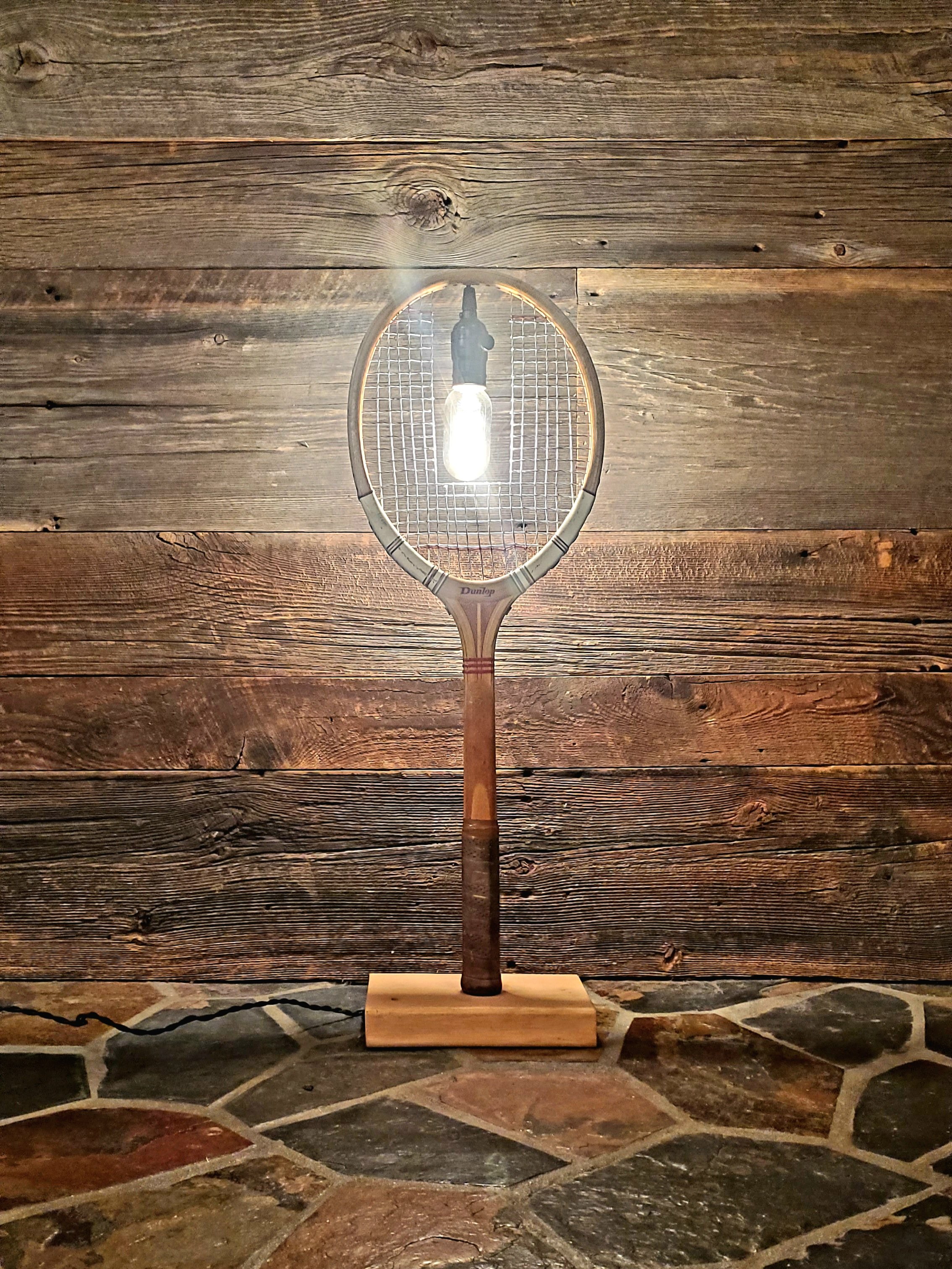 Image 1 of 3
Image 1 of 3

 Image 2 of 3
Image 2 of 3

 Image 3 of 3
Image 3 of 3




Vintage Dunlop Wooden Tennis Racket Table Lamp
Vintage Dunlop Wooden Tennis Racket Upcycled into an Accent Table Lamp.
See below for the history of the Tennis Racket:
Dimensions 9 x 5 1/2 x 28 inches
Lovingly restored with gentle cleaners to remove years of rust. Evidence of use and character make the piece truly authentic!
9 foot long black vintage styled pendant fabric cord with 2-prong plug.
Antique brass standard Edison socket to accommodate any standard light bulb not to exceed 100W hangs suspended from the wheel rim
Vintage-inspired, brand new, hand-spun Edison light bulb 40W. Replacements readily available. Not all light bulbs will look the same. Fragile.
Flat Fee Shipping $20.00 within the US
Vintage Dunlop Wooden Tennis Racket Upcycled into an Accent Table Lamp.
See below for the history of the Tennis Racket:
Dimensions 9 x 5 1/2 x 28 inches
Lovingly restored with gentle cleaners to remove years of rust. Evidence of use and character make the piece truly authentic!
9 foot long black vintage styled pendant fabric cord with 2-prong plug.
Antique brass standard Edison socket to accommodate any standard light bulb not to exceed 100W hangs suspended from the wheel rim
Vintage-inspired, brand new, hand-spun Edison light bulb 40W. Replacements readily available. Not all light bulbs will look the same. Fragile.
Flat Fee Shipping $20.00 within the US
Vintage Dunlop Wooden Tennis Racket Upcycled into an Accent Table Lamp.
See below for the history of the Tennis Racket:
Dimensions 9 x 5 1/2 x 28 inches
Lovingly restored with gentle cleaners to remove years of rust. Evidence of use and character make the piece truly authentic!
9 foot long black vintage styled pendant fabric cord with 2-prong plug.
Antique brass standard Edison socket to accommodate any standard light bulb not to exceed 100W hangs suspended from the wheel rim
Vintage-inspired, brand new, hand-spun Edison light bulb 40W. Replacements readily available. Not all light bulbs will look the same. Fragile.
Flat Fee Shipping $20.00 within the US
Historians believe the earliest version of tennis was invented by the ancient Egyptians, but they didn’t use rackets. Instead, they struck the ball with the palm of their hand (called the “rahat”), which was said to have been the origin of the word “racket”.
Prior to the 14th century, tennis-type games were played using bare hands, but French monks realised there must be a better way to hit the ball over the net, after suffering finger injuries. Initially, they began to wear specially designed leather gloves. Then, they decided to use solid wooden paddles, finally progressing onto what resembled a racket in the 14th century. An early description of a tennis racket in the 15th century said it was made of cork wrapped in cloth, with strings fashioned from sheep’s intestines. The cloth was later replaced by leather. Rackets didn’t need to be particularly sturdy, since the balls weighed only around three ounces and were made of cork.
This type of basic racket didn’t change until the 19th century, when the first modern racket was invented by Major Walter Clopton Wingfield, a British Army officer, who had graduated from the Royal Military College, Sandhurst.
Despite his military background, he was also an inventor and the pioneer of lawn tennis. The wooden racket remained almost the same until 1947, when a new, more flexible, laminated wooden frame was introduced. During the 20th century, the main manufacturers of wooden tennis rackers included Slazenger, Dunlop, Wilson and Spalding. Smaller manufacturers tended to close down, as they couldn’t compete with the giants of the industry.
Although people associated metal rackets with the late 20th century, they had been around for much longer as early prototypes, but never really took off. The first metal racket was patented in 1957 by René Lacoste. Wilson bought the rights to it and their metal racket first appeared in the 1969 Wilson catalogue.
Famous American player, Jimmy Connors, ensured metal rackets gained mass popularity in the 1970s as a result of his amazing success using a powerful steel racket. It had a devastating effect on many of his opponents who used wooden rackers and the metal version finally took off.